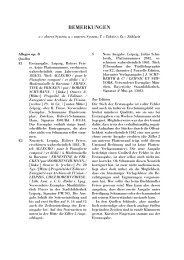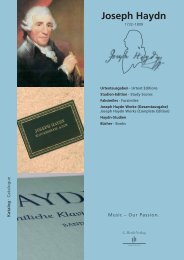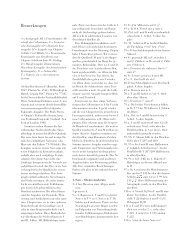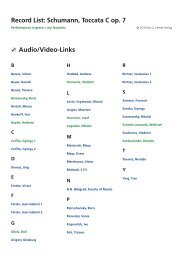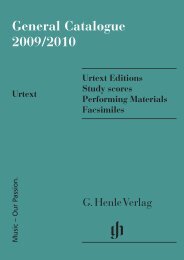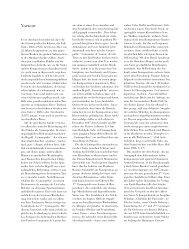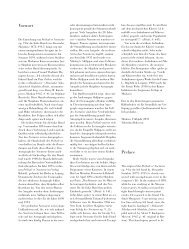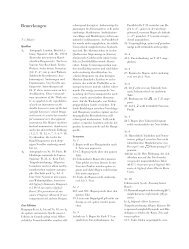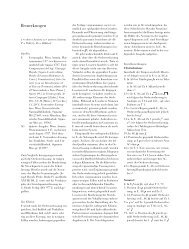Bemerkungen - Henle Verlag
Bemerkungen - Henle Verlag
Bemerkungen - Henle Verlag
Sie wollen auch ein ePaper? Erhöhen Sie die Reichweite Ihrer Titel.
YUMPU macht aus Druck-PDFs automatisch weboptimierte ePaper, die Google liebt.
14<br />
<strong>Bemerkungen</strong><br />
o = oberes System; u = unteres System;<br />
T = Takt(e)<br />
Quellen<br />
A Autograph. Das Manuskript wurde<br />
zu einem unbekannten Zeitpunkt,<br />
wahrscheinlich von Clara<br />
Schumann, in verschiedene Teile<br />
aufgeteilt und befindet sich heute<br />
in drei Bibliotheken. Von Nr. 1<br />
sind zwei größere Teile verloren<br />
gegangen.<br />
Nr. 1: T 1–32 und 57–62 fehlen,<br />
T 33–56 im Robert-Schumann-Haus,<br />
Zwickau, Signatur<br />
10307-A1; T 63 in der Russischen<br />
Nationalbibliothek, St. Petersburg,<br />
Signatur RNB. F. 965, Waksel<br />
P.L., Nr. 2452.<br />
Nr. 2: T 1–22 (= T 50–70) in<br />
der Russischen Nationalbibliothek,<br />
St. Petersburg, Signatur RNB.<br />
F. 965, Waksel P.L., Nr. 2452;<br />
T 23–24 (= T 71–72), 25,<br />
42–49, 73–77 im Robert-Schumann-Haus,<br />
Zwickau, Signatur<br />
10307-A1; T 26–41 in der Newberry<br />
Library, Chicago, Signatur<br />
CASE MS 8A 108.<br />
Nr. 3: komplett in der Newberry<br />
Library, Chicago, Signatur CASE<br />
MS 8A 108.<br />
Die Manuskriptteile in St. Petersburg<br />
und Chicago enthalten<br />
Signierungen von Clara Schumann.<br />
Die zwei Blätter in der<br />
Newberry Library in Chicago enthalten<br />
auch einen noch abweichenden<br />
Anfangsteil zu Nr. 2.<br />
Verschiedene Verweiszeichen in<br />
allen Manuskriptteilen beweisen<br />
eindeutig, dass es sich ursprünglich<br />
um ein zusammenhängendes<br />
Autograph handelte. Der Notentext<br />
stimmt mit der Druckfassung<br />
bereits weitgehend überein. Die<br />
Einstufung als Skizze im Schumann<br />
Werkverzeichnis von Margit<br />
McCorkle ist unzutreffend.<br />
ABStv Kopistenabschrift mit zahlreichen<br />
Korrekturen und Ergänzungen<br />
von Schumann, Stichvorlage.<br />
Leipzig, Universitätsbibliothek,<br />
Sammlung Taut, Signatur 3525.<br />
Titel: [von fremder Hand:] Drei<br />
Fantasiestücke / [darunter zwei<br />
Titelentwürfe von Schumann, alle<br />
durchgestrichen:] Drei Clavierstücke<br />
/ III / Stücke / für den Flügel<br />
[links daneben, von Schumann:]<br />
Ihro Durchlaucht / Frau Fürstin<br />
Reuss=Köstritz / geb. Gräfin Castell<br />
/ zugeeignet [etwas unterhalb<br />
der Blattmitte, links, von Schumann:]<br />
Düsseldorf. August 1851<br />
[rechts:] R. Schumann [darunter<br />
auf Mitte, von fremder Hand:]<br />
op. 111 / [Plattennummer vom<br />
<strong>Verlag</strong>:] 3525.<br />
EH Erstausgabe. Leipzig, C. F. Peters,<br />
Plattennummer „3525“, erschienen<br />
im Juli 1852. Titel: Drei /<br />
FANTASIESTÜCKE / für / PIANO-<br />
FORTE / IHRO DURCHLAUCHT /<br />
Frau Fürstin Reuss-Köstritz / GEB.<br />
GRÄFIN CASTELL / zugeeignet /<br />
von / ROBERT SCHUMANN. /<br />
OP. 111. / Leipzig / IM BUREAU<br />
DE MUSIQUE VON C. F. PETERS.<br />
/ [links:] LONDON J. J. EWER &<br />
Co [rechts:] St. PETERSBURG M.<br />
BERNARD. / Pr. 20 Ngr. / Ent. Sta.<br />
Hall. / 3525. Verwendetes Exemplar:<br />
Handexemplar Schumanns<br />
mit einigen Bleistifteintragungen,<br />
die aber nicht alle von Schumann<br />
stammen dürften. Zwickau, Robert-Schumann-Haus,<br />
Signatur<br />
4501/Bd. 19-D1/A4.<br />
Zur Edition<br />
Als Hauptquelle ist eindeutig die Erstausgabe<br />
anzusehen, denn Schumann<br />
hat sie Korrektur gelesen und dabei<br />
auch noch einige wenige Änderungen<br />
vorgenommen. Dennoch blieben im Notentext<br />
des Druckes einige Fehler stehen,<br />
die durch den Vergleich mit dem<br />
Autograph und der Stichvorlage entdeckt<br />
und beseitigt werden konnten. Im<br />
Autograph fehlen sämtliche Metronomund<br />
Fingersatzangaben. In der Erstausgabe<br />
sind erstere in Klammern gesetzt.<br />
Die Vorschlagsnoten sind im Autograph<br />
und zum Teil auch in der Stichvorlage<br />
als 8 , in der Erstausgabe jedoch,<br />
wie in dieser Ausgabe wiedergegeben,<br />
einheitlich als 1 notiert.<br />
Einzelbemerkungen<br />
Nr. 1 Sehr rasch, mit leidenschaftlichem<br />
Vortrag<br />
1 o: In EH mit Bleistift (wohl nicht von<br />
Schumann) hier und in den meisten<br />
analogen Takten Sonderhalsung:<br />
������������ �� �<br />
�<br />
�� �<br />
�<br />
��� �<br />
2 u: Position des p kurz nach dem Akkord<br />
auf Eins entspricht der Bezeichnung<br />
in AB Stv und an den analogen<br />
Stellen in A. In E H hier und an den<br />
meisten anderen Stellen direkt auf<br />
Eins.<br />
10–16: In AB Stv , E H nicht ausgestochen;<br />
stattdessen T 2–9 m ,, sowie prima<br />
und seconda volta mit der Bezeichnung<br />
Das I ste mal und Das II te mal.<br />
37 f. u: Nach A wohl eher Bogenteilung<br />
zwischen letzter Note T 37 und 1. Note<br />
T 38 gemeint; Bogen in T 37, wie<br />
oft bei Schumann, etwas zu weit nach<br />
rechts und daher in AB Stv vom Kopisten<br />
bis Eins T 38 gezogen. Entsprechend<br />
auch in E H . In beiden Quellen<br />
allerdings an der analogen Stelle<br />
T 7 f. durchgezogener Bogen; da A<br />
für diesen Teil nicht vorliegt, ist letztlich<br />
nicht zu entscheiden, welche Bogensetzung<br />
Schumann gemeint hat.<br />
39 b u: 2. und 3. Triolengruppe in A und<br />
danach auch in AB Stv, E H im V im<br />
unteren System notiert, Bogen wohl<br />
aus diesem Grund nur zu diesen<br />
sechs Noten gesetzt. Für den analogen<br />
T 17 fehlt A. In AB Stv T 17 (mit<br />
m , siehe Bemerkung zu T 10–16), in<br />
E H T 39 a , in beiden Fällen mit ganztaktigem<br />
Bogen.<br />
61 f. u: Bogen in AB Stv jeweils nur bis<br />
Taktende.<br />
Nr. 2 Ziemlich langsam<br />
1 ff. u: In A noch Vorschlagsnoten wie in<br />
der rechten Hand.<br />
2 o: Bogen nach A; in ABStv , EH bis<br />
2. Note, vielleicht weil in A, wie so oft
ei Schumann, etwas über die 1. Note<br />
hinaus gezogen. Die den T 2–4<br />
entsprechenden T 18–20 sind in A<br />
nicht ausgeschrieben, sondern nur<br />
durch Verweisziffern angedeutet.<br />
Nach aller Erfahrung nehmen Kopisten<br />
für solche Abschnitte ihre eigene<br />
Niederschrift als Vorlage, so dass<br />
auch in T 18 in AB Stv, E H der Bogen<br />
bis zur 2. Note gezogen ist. Bei der<br />
Wiederholung des gesamten Anfangsteils<br />
notierte der Kopist jedoch an<br />
beiden Stellen den kürzeren Bogen.<br />
5 f. u: Bogen fehlt in A, AB Stv.<br />
12 o: Haltebogen es 1 –es 1 nur in A, wo<br />
er leicht zu übersehen ist; analoge<br />
Stelle T 60 in A nicht ausgeschrieben,<br />
also gleichlautend gemeint.<br />
13, 61 o: In diesen beiden Takten auch<br />
in E H langer Vorschlag.<br />
14, 62 o: Notierung der letzten s über<br />
dem letzten Triolenachtel so nach allen<br />
Quellen. Dabei stellt sich freilich<br />
die Frage, wie die vorangehenden<br />
punktierten Figuren zu spielen sind.<br />
27: z nur in A.<br />
27–29: Bogensetzung in A unklar, teils<br />
wegen Platzproblemen, teils weil, wie<br />
oft bei Schumann, zu weit nach links<br />
oder rechts gezogen: T 27 f. u Bogen<br />
erst ab Eins T 28, Platzprobleme;<br />
T 29 o Bogen zu weit nach links gezogen<br />
und daher in AB Stv , E H bereits<br />
ab letzter Note T 28 o; T 29 u Bogen<br />
etwas zu weit nach rechts und daher<br />
in AB Stv , E H bis 3. Note. Man kann<br />
aber wohl davon ausgehen, dass für<br />
rechte und linke Hand die gleiche<br />
Phrasierung gemeint ist.<br />
30 f. o: Bogen in AB Stv, E H durchgezogen<br />
– wohl weil in A der neue Bogen<br />
in T 31 etwas zu weit links beginnt;<br />
vgl. jedoch die analogen Stellen<br />
T 26 f. und 42 f.<br />
34 ff.: Wie so oft bei Schumann taucht<br />
die Frage auf, ob die s zusammen<br />
mit dem jeweils dritten Triolenachtel<br />
anzuschlagen sind oder danach. In<br />
E H hier alle s nachschlagend notiert,<br />
außer in T 34; in handschriftlichen<br />
Quellen eher ungenaue Positionierung,<br />
jedoch nur in AB Stv T 39 eindeutig<br />
nachschlagend notiert. Der<br />
Herausgeber entscheidet sich für die<br />
einheitliche Wiedergabe der Notie-<br />
rung in A; nachschlagende Notierung<br />
in E H vermutlich Standardisierung<br />
durch Stecher. Siehe auch<br />
Bemerkung zu T 14, 62.<br />
35 o: 1. Note in A v statt h , was angesichts<br />
der 4. Note der Mittelstimme<br />
durchaus sinnvoll wäre; in AB Stv<br />
jedoch von Schumann korrigiert.<br />
38 o: 6. Note der Mittelstimme in A c 1<br />
statt a; dies würde aber die Oktavenfolge<br />
Mittelstimme–Oberstimme<br />
unterbrechen.<br />
40 f. u: Die fünf Oktaven in A noch<br />
ohne die Akkordtöne B und G.<br />
45 o: Bogen nach A; in AB Stv, E H bereits<br />
ab letzter Note T 44. Siehe Bemerkung<br />
zu T 27–29.<br />
56 o: Vorschlagsnote as 1 nach A; dort<br />
sind T 50–72 nicht ausgeschrieben,<br />
sondern nur als Wiederholung von<br />
T 2–24 ausgewiesen. Das bedeutet,<br />
dass Schumann diese Takte gleichlautend<br />
haben wollte. Der Kopist von<br />
AB Stv vergaß, den Vorschlag zu notieren.<br />
61 f. o: Bögen zu den punktierten<br />
Figuren der Mittelstimme nach A<br />
(= T 13 f.); fehlen in AB Stv, E H.<br />
65 u: In T 17 strich Schumann den Vorschlag<br />
aus; hier diese Korrektur nur<br />
vergessen?<br />
66 f.: Bogen über Taktstrich hinweg so<br />
nach AB Stv, E H; in A nur bis Ende<br />
T 66 (= T 18; siehe Bemerkung zu<br />
T 56). Schumann hat jedoch den Bogen<br />
in AB Stv nachträglich bis Eins<br />
T 66 verlängert. Sollte diese Korrektur<br />
für alle analogen Stellen – T 2 f.,<br />
6 f., 18 f., 50 f., 54 f. – gemeint sein?<br />
Nr. 3 Kräftig und sehr markiert<br />
8 u: In EH 2. Note zusätzlich mit es;<br />
wohl Fehldeutung eines Flecks in<br />
ABStv ; vgl. auch T 40.<br />
12, 44 o: 3. Akkord in ABStv, EH zusätzlich<br />
mit g, das jedoch mit der melodieführenden<br />
Stimme kollidieren<br />
würde; in A ist die Note gestrichen.<br />
17–32: In A ohne Wiederholungszeichen,<br />
allerdings am Rand der Hinweis:<br />
NB. Wiederholung. Entsprechend<br />
fehlen natürlich auch die<br />
Prima-volta-Takte 24a und 32a.<br />
15<br />
17: ten. nicht in A; stattdessen Portatobezeichnung<br />
wie in den folgenden<br />
Takten. In AB Stv von Schumann korrigiert.<br />
Sollte die Korrektur möglicherweise<br />
auch für die anderen mit<br />
Portato bezeichneten Takte gelten?<br />
48 o: 2. Akkord der Mittelstimme in<br />
AB Stv , E H ohne g; wohl Versehen: in<br />
A sind T 33–48 nicht ausgeschrieben,<br />
sondern nur als Wiederholung<br />
von T 1–16 ausgewiesen. Das bedeutet<br />
aber, dass Schumann diese Takte<br />
gleichlautend haben wollte.<br />
Remagen, Herbst 2009<br />
Ernst Herttrich<br />
Comments<br />
u = upper staff; l = lower staff;<br />
M = measure(s)<br />
Sources<br />
A Autograph. The manuscript was<br />
split up into various segments at<br />
an unknown date, probably by<br />
Clara Schumann, and is now located<br />
in three libraries. Two large<br />
parts of No. 1 have been lost.<br />
No. 1: M 1–32 and 57–62 are<br />
missing, M 33–56 in the Robert-<br />
Schumann-Haus, Zwickau, shelfmark<br />
10307-A1; M 63 in the Russian<br />
National Library, St. Petersburg,<br />
shelfmark RNB. F. 965,<br />
Waksel P.L., No. 2452.<br />
No. 2: M 1–22 (= M 50–70) in<br />
the Russian National Library,
16<br />
St. Petersburg, shelfmark RNB.<br />
F. 965, Waksel P.L., No. 2452;<br />
M 23–24 (= M 71–72), 25, 42–<br />
49, 73–77 in the Robert-Schumann-Haus,<br />
Zwickau, shelfmark<br />
10307-A1; M 26–41 in the Newberry<br />
Library, Chicago, shelfmark<br />
CASE MS 8A 108.<br />
No. 3: Preserved in full in the<br />
Newberry Library, Chicago, shelfmark<br />
CASE MS 8A 108.<br />
The manuscript sections in<br />
St. Petersburg and Chicago contain<br />
markings by Clara Schumann.<br />
The two leaves in the Newberry<br />
Library in Chicago also contain<br />
a still divergent opening section<br />
to No. 2.<br />
Various reference marks in all<br />
manuscript sections prove without<br />
the shadow of a doubt that<br />
this was originally one cohesive<br />
autograph. The musical text already<br />
broadly agrees with that of<br />
the printed version. The categorisation<br />
as sketch in the Schumann<br />
Werkverzeichnis by Margit Mc-<br />
Corkle is unfounded.<br />
CEC Copyist’s transcription with many<br />
corrections and additions by<br />
Schumann, engraver’s copy. Leipzig,<br />
Universitätsbibliothek,<br />
Sammlung Taut, shelfmark 3525.<br />
Title: [in another hand:] Drei Fantasiestücke<br />
/ [below this, two title<br />
ideas by Schumann, both crossed<br />
out:] Drei Clavierstücke / III /<br />
Stücke / für den Flügel [to the left,<br />
in Schumann’s hand:] Ihro Durchlaucht<br />
/ Frau Fürstin Reuss=Köstritz<br />
/ geb. Gräfin Castell / zugeeignet<br />
[a little below the centre of the<br />
page, to the left, in Schumann’s<br />
hand:] Düsseldorf. August 1851<br />
[to the right:] R. Schumann [below<br />
this, in the centre, in another<br />
hand:] op. 111 / [publisher’s plate<br />
number:] 3525.<br />
FCC First edition. Leipzig, C. F. Peters,<br />
plate number “3525”, published<br />
in July 1852. Title: Drei / FAN-<br />
TASIESTÜCKE / für / PIANOFOR-<br />
TE / IHRO DURCHLAUCHT /<br />
Frau Fürstin Reuss-Köstritz / GEB.<br />
GRÄFIN CASTELL / zugeeignet /<br />
von / ROBERT SCHUMANN. /<br />
OP. 111. / Leipzig / IM BUREAU<br />
DE MUSIQUE VON C. F. PETERS. /<br />
[to the left:] LONDON J. J. EWER<br />
& C o [to the right:] S t. PETERS-<br />
BURG M. BERNARD. / Pr. 20 Ngr. /<br />
Ent. Sta. Hall. / 3525. Copy consulted:<br />
Composer’s copy, contains<br />
several entries in pencil, which<br />
probably do not all stem from<br />
Schumann. Zwickau, Robert-<br />
Schumann-Haus, shelfmark<br />
4501/Bd. 19-D1/A4.<br />
About this edition<br />
The first edition clearly deserves the<br />
status of the primary source, since<br />
Schumann corrected the proofs and<br />
made a few changes in them. Nevertheless,<br />
a few errors remained in the printed<br />
text, which we have been able to detect<br />
and remove by comparing it with<br />
the autograph and engraver’s copy. All<br />
the metronome markings and fingerings<br />
are still missing in the autograph. The<br />
former were placed in parentheses in<br />
the first edition.<br />
The appoggiaturas are notated as 8<br />
in the autograph and, in part, in the engraver’s<br />
copy as well; however, they are<br />
notated uniformly as 1 in the first edition,<br />
the notation we have adopted here.<br />
Individual comments<br />
No. 1 Sehr rasch, mit leidenschaftlichem<br />
Vortrag<br />
1 u: In FCC special stemming in pencil<br />
(presumably not from Schumann)<br />
here and in most analogous measures:<br />
������������ �� �<br />
�<br />
�� �<br />
�<br />
��� �<br />
2 l: Position of the p on 1 st beat shortly<br />
after the chord agrees with the marking<br />
in C EC and in the analogous passages<br />
in A. In F CC here and at most<br />
other passages directly on 1 st beat.<br />
10–16: In C EC, F CC not printed out; instead<br />
M 2–9 m , as well as prima and<br />
seconda volta with the indication Das<br />
I ste mal and Das II te mal.<br />
37 f. l: According to A, a separation of<br />
the slur between the last note of M 37<br />
and the 1 st note of M 38 is apparently<br />
intended. The slur in M 37 is drawn<br />
somewhat too far to the right – as occurs<br />
frequently in Schumann’s manuscripts<br />
– and thus extended by the<br />
copyist in C EC up to the 1 st beat of<br />
M 38. Likewise in F CC . In both sources,<br />
however, a single slur at the analogous<br />
passages M 7 f.; since A lacks<br />
this section, it is ultimately impossible<br />
to decide which slurring Schumann<br />
intended.<br />
39 b l: 2 nd and 3 rd triplet groups notated<br />
in V in the lower staff in A, then also<br />
in C EC , F CC . Slur thus placed only over<br />
these six notes most likely for this<br />
reason. The analogous M 17 is missing<br />
in A. In C EC M 17 (with m , see<br />
note at M 10–16), in F CC M 39 a , in<br />
both cases with measure-long slurs.<br />
61 f. l: Slur in C EC extends only to end<br />
of measure respectively.<br />
No. 2 Ziemlich langsam<br />
1 ff. l: In A appoggiatura notes as in the<br />
right hand.<br />
2 u: Slur from A; in CEC , FCC up to<br />
2nd note, perhaps because in A, as<br />
so often with Schumann, the slur<br />
was drawn somewhat beyond the<br />
1st note. M 18–20, which correspond<br />
to M 2–4, are not written out in A,<br />
but only indicated with reference<br />
numbers. Judging from experience,<br />
copyists usually base themselves on<br />
their own copy for such sections,<br />
which would result in the slur being<br />
extended to the 2nd note in M 18 in<br />
CEC, FCC as well. However, at the repetition<br />
of the entire opening section,<br />
the copyist notated the shorter slur at<br />
both passages.<br />
5 f. l: Slur missing in A/CEC .<br />
12 u: Tie eb1 –eb1 only in A, where it is<br />
easy to overlook; the analogous passage<br />
at M 60 in A is not written out,<br />
thus intended to sound the same.<br />
13, 61 u: Longer appoggiatura in these<br />
two measures also in FCC. 14, 62 u: Notation of last s above last<br />
triplet eighth in all sources. This raises<br />
the question as to how the preceding<br />
dotted figures are to be played.<br />
27: z only in A.
27–29: Slurring in A unclear, partly<br />
because of lack of space, partly because,<br />
as so often with Schumann,<br />
drawn too far to the left or the right:<br />
in M 27 f. l slur begins at 1 st beat of<br />
M 28, space problems; in M 29 u slur<br />
begins too far to the left and thus in<br />
C EC , F CC is drawn from last note of<br />
M 28 u; M 29 l slur is drawn a bit<br />
too far to the right and thus up to<br />
3 rd note in C EC, F CC. However, one<br />
can well assume that the same phrasing<br />
is intended for the right and the<br />
left hand.<br />
30 f. u: One sole slur in C EC , F CC , probably<br />
because in A the new slur in M 31<br />
begins a bit too far to the left; but see<br />
the analogous passages at M 26 f. and<br />
42 f.<br />
34 ff.: As so often with Schumann, the<br />
question arises as to whether the s<br />
are to be played together with the<br />
third triplet eighth or afterwards. In<br />
F CC here all s are notated in a staggered<br />
pattern except for M 34; in<br />
manuscript sources tendency towards<br />
imprecise positioning, but only in C EC<br />
M 39 unequivocally notated in staggered<br />
fashion. The editor has chosen<br />
the uniform notation of A; staggered<br />
notation in F CC presumably a standardisation<br />
made by the engraver. See<br />
also note at M 14, 62.<br />
35 u: 1 st note in A v instead of h ,<br />
which is very plausible in view of<br />
the 4 th note of the middle voice; in<br />
C EC, however, corrected by Schumann.<br />
38 u: 6 th note of the middle part c 1 instead<br />
of a in A; however, this would<br />
interrupt the octave sequence middle<br />
part–upper part.<br />
40 f. l: The five octaves still without the<br />
chordal notes Bb and G in A.<br />
45 u: Slur from A; in C EC , F CC it begins<br />
at last note M 44. See comment on<br />
M 27–29.<br />
56 u: Appoggiatura note ab 1 from A;<br />
there M 50–72 are not written out,<br />
but only indicated as repeat of M 2–<br />
24. This means that Schumann<br />
wanted these measures to sound<br />
identically. The copyist of C EC forgot<br />
to notate the appoggiatura.<br />
61 f. u: Slurs over the dotted figures of<br />
the middle part from A (= M 13 f.);<br />
missing in C EC, F CC.<br />
65 l: In M 17 Schumann crossed out the<br />
appoggiatura; correction forgotten<br />
here?<br />
66 f.: Slur extending beyond bar line as<br />
such in C EC, F CC; in A only up to the<br />
end of M 66 (= M 18; see comment<br />
on M 56). However, Schumann later<br />
extended the slur in C EC up to 1 st beat<br />
of M 66. Is this correction intended<br />
for all analogous passages, M 2 f.,<br />
6 f., 18 f., 50 f., 54 f.?<br />
17<br />
No. 3 Kräftig und sehr markiert<br />
8 l: In FCC 2nd note also with eb ; probably<br />
a misinterpretation of a smudge<br />
in CEC ; see also M 40.<br />
12, 44 u: 3rd chord in CEC, FCC also with<br />
g; this, however, would collide with<br />
the melodic line; in A the note is<br />
crossed out.<br />
17–32: In A without repeat sign, but<br />
with the following indication in the<br />
margin: NB. Wiederholung (repeat).<br />
Accordingly the prima volta M 24a<br />
and 32a are also missing.<br />
17: ten. not in A; instead, portato indication<br />
as in the following measures.<br />
In CEC corrected by Schumann. Does<br />
the correction possibly also apply to<br />
the other measures with the portato<br />
marking?<br />
48 u: 2nd chord of the middle voice in<br />
CEC , FCC without g, probably an oversight:<br />
in A M 33–48 not written<br />
out, but only indicated as repeat of<br />
M 1–16. This means, however, that<br />
Schumann wanted to have these<br />
measures sound the same.<br />
Remagen, autumn 2009<br />
Ernst Herttrich



